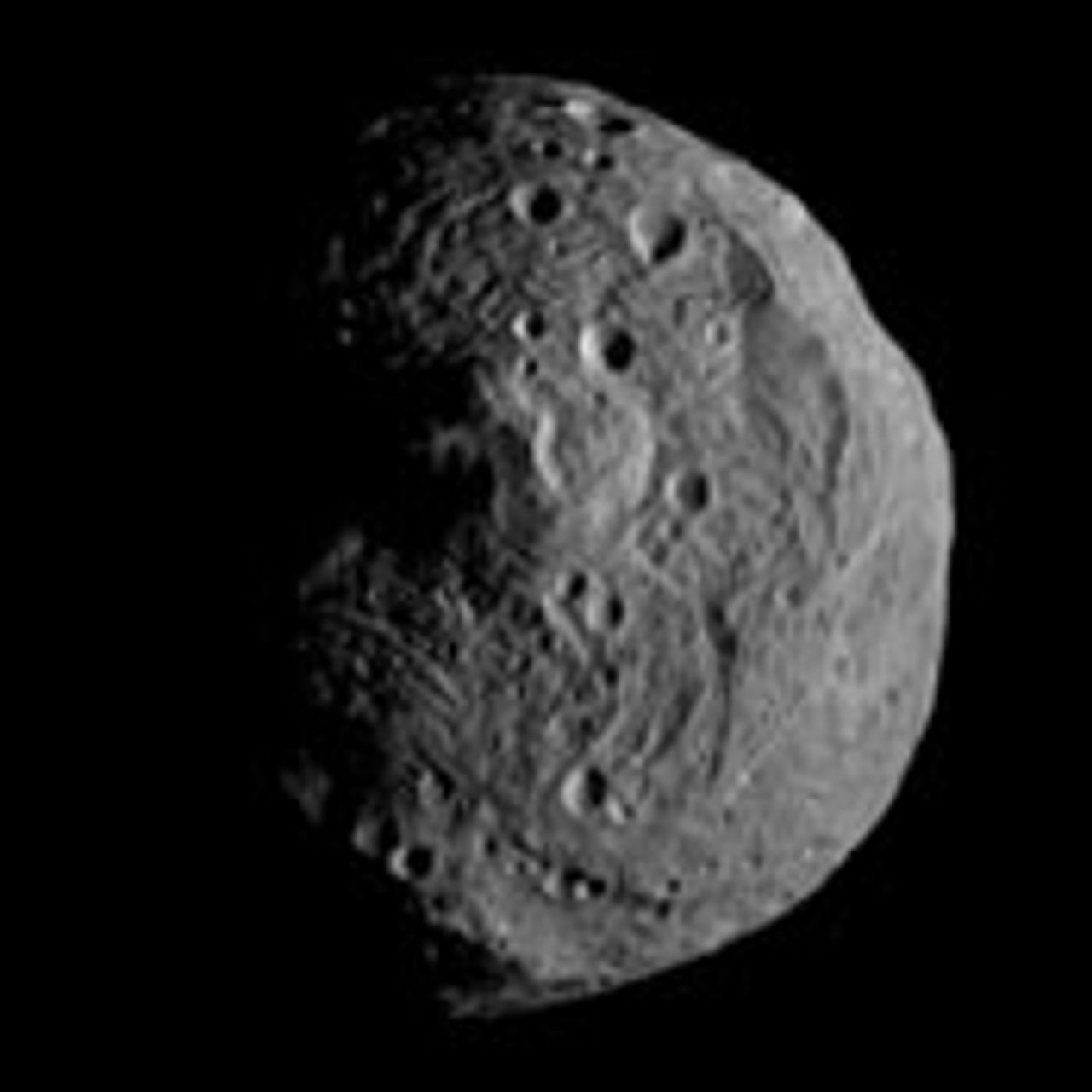 A photograph of Vesta, taken
A photograph of Vesta, takenfrom the Dawn spacecraft at a
distance of 10,000 miles.
After a journey of nearly four years, NASA's Dawn spacecraft has entered orbit around Vesta, the second-largest asteroid, and is beginning to capture images of its surface.
The rendezvous with Vesta took place late on the evening of July 15, California time, according to mission controllers at the Jet Propulsion Laboratory in Pasadena. However, this could not be confirmed until the spacecraft's antenna was oriented towards the Earth, more than a day later.
Vesta is an oddly shaped rock, 359 miles by 348 miles by 285 miles—each dimension about the width of Arizona. Its low gravity, only 2 percent of the Earth's, will accelerate the spacecraft by about 100 miles per hour, a very low gravitational pull compared to that of Mars, Venus, Mercury, or the outer planets. This means that the velocity at which the spacecraft must travel to avoid being pulled down to the asteroid by gravity is very small compared to that required for missions orbiting planets.
The spacecraft will edge in slowly towards the surface of the asteroid for the next three weeks, looking for moons and making observations, mainly to assist its own navigation into the closest possible orbit around Vesta.
Sometime in August it will settle in for a year-long period of intense scrutiny of the asteroid. It will then move on to the largest asteroid, Ceres, some 600 miles in diameter, which it is scheduled to reach in February 2015.
Ceres is so large that it is actually classified by astronomers as a dwarf planet, and it is believed to have the largest reservoir of water in the solar system, outside of the Earth. If Dawn is successful in reaching it, the spacecraft will be the first to visit two separate extraterrestrial bodies.
The asteroids are believed to be some of the original component parts of the solar system at the time of planetary formation 4.5 billion years ago. The belt of matter orbiting the Sun between Mars and Jupiter might have condensed into another planet, but for the disruptive effect of Jupiter's huge gravitational attraction.
In a statement issued from JPL, the mission's principal investigator, Christopher Russell of UCLA, said, “We are beginning the study of arguably the oldest extant primordial surface in the solar system.”
“This region of space has been ignored for far too long. So far, the images received to date reveal a complex surface that seems to have preserved some of the earliest events in Vesta's history, as well as logging the onslaught that Vesta has suffered in the intervening eons.”
Already the first pictures show craters, slopes and indentations in the surface that could not be distinguished even by the Hubble Space Telescope.
Instruments will study the chemical composition of the surface of the planet, looking particularly for evidence of volcanism, which is believed to have played a role in changing the surface over time, through eruptions and lava flows.
Vesta may provide new knowledge about the Sun as well, since it began receiving solar radiation on its unprotected surface almost as soon as the solar system assumed its current form.
Dawn has travelled 1.7 billion miles since it was borne aloft in September 2007 from Cape Canaveral, Florida. It entered orbit at a distance of less than 10,000 miles from Vesta, and 117 million miles from Earth. Dawn had to travel 1.7 billion miles—which is much further than the current straight-line distance from the Earth to Vesta—because of the orbital mechanics involved in launching a craft from a heavy, moving object (the Earth) to another.
The spacecraft uses a low-power ion propulsion drive, firing the inert gas xenon, which is given an electrical charge from Dawn's solar panels. As the charged gas shoots out a nozzle, it gives a tiny push, no greater than the weight of a sheet of paper on your hand, according to the illustration given by Mark Rayman, chief engineer for Dawn at JPL.
This tiny thrust, accumulating steadily for more than 1,000 days, has increased the speed of the spacecraft to a remarkable degree, since there is effectively no drag or resistance in space. By the end of the mission in 2016, the ion propulsion drive will have given Dawn the equivalent of 24,000 miles per hour in velocity, using only 937 pounds of fuel.
Dawn was originally scheduled for the summer of 2006, but technical problems delayed the launch after budgetary issues nearly led to its cancellation outright. NASA killed the project early in 2006, but JPL scientists opposed the action and persuaded the agency leadership to reverse it. As it is, the cost of the four-year mission is $466 million—less than two days' operating costs for the war in Afghanistan.
